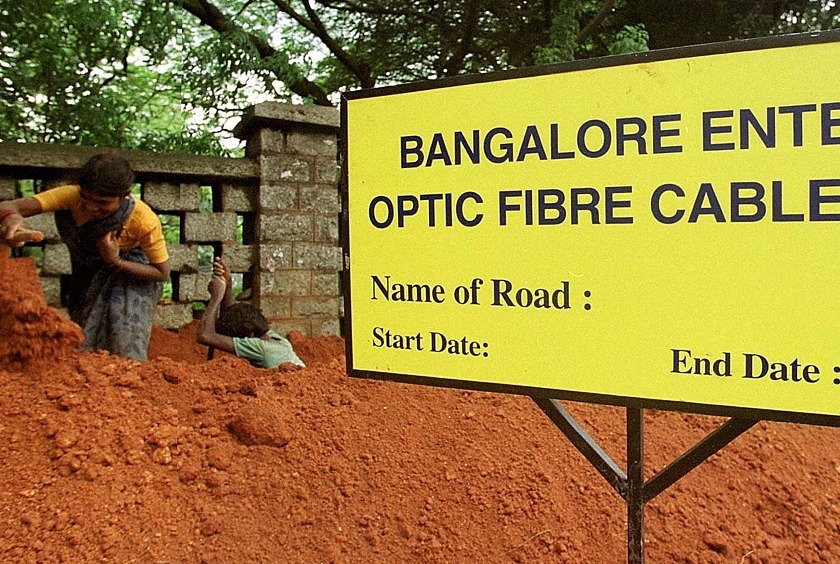Politics
National Optical Fibre Network: Modi’s Pet Project Gains Momentum But Still Has A Long Way To Go
- The National Optical Fibre Network has been touted as one of the most important building blocks of Digital India.
- However, the progress in implementing the project has been very slow despite being better than that in the UPA years.

Workers dig up a trench before laying fibre optic cables in Bengaluru. (INDRANIL MUKHERJEE/AFP/Getty Images)
Digital India is back in the public discourse. But it has less to do with such things as the Legion’s hacking of twitter accounts and emails of India’s rich and influential and more to do with Prime Minister Narendra Modi’s announcement of the withdrawal of old high denomination currency notes on 8 November.
After the so-called demonetisation, the government has been vigorously pushing for digital payments. However, India’s poor internet penetration is proving to be a major roadblock to its aim of turning India into a less-cash economy. That’s also a major reason that metros like Bengaluru or Mumbai are coping well while rural and semi-urban areas are struggling with the cash crunch.
So, the question that comes up at this point is, what has the government done so far in casting the digital net far and wide to cover most parts of the country?
In 2015, the Modi government launched ‘Digital India’, one of its most ambitious projects. At the time, Modi had talked about his “dream of a digital India where high-speed Digital Highways unite the nation”. Of its nine pillars, the National Optical Fibre Network (NOFN) was touted as one of the most important building blocks of Digital India. Without NOFN, there is no Digital India.
Under NOFN, the government aimed to connect 2,44,729 Gram Panchayats (GPs) in the country through optical fibre cable (OFC). In June 2016, when Swarajya reviewed its implementation status, the project seemed to be languishing: 1,30,000km of fibre cable had been laid, covering 7,000 GPs. While the progress compared to the United Progressive Alliance years was impressive (it had laid only 500km of cable in three years), it was a far cry from the intended target.
Three state-run agencies, namely Bharat Sanchar Nigam Ltd (BSNL), RailTel and Power Grid Corporation of India Limited (PGCIL), were entrusted with laying the OFC in 84,366 GPs, 8,678 GPs and 7,156 GPs respectively. However, by the end of 2015, they were running behind their targets: BSNL had laid 37,822km of OFC (22 per cent of its target), PGCIL, 3,110km (14 per cent of its target) and RailTel, only 1,717km (8 per cent of its target). RailTel was the biggest laggard. It picked up pace after the intervention of the Information Technology minister. By March 2016, it had laid 6,152km of OFC, averaging the laying of cable at 500km per month.
What’s the status now?
The government had said that of the 2,44,729 GPs, it would be able to cover 97,480 GPs in Phase-1 by 31 March 2017. As of 4 December, it has laid OFC in 76,728 GPs and optical fibre in 64,599 GPs. This is pretty impressive.
The coverage target appears within reach now. However, the laying of OFC is not enough. The final objective is to make sure that all GPs go live and start functioning. In this regard, the progress is disappointing. So far there are only 14,569 live GPs. Here, the government needs to accelerate the progress and make sure that all its investments in laying such massive infrastructure don’t go waste on account of last-mile challenges.
Even after all GPs go live, there are other challenges, such as high maintenance costs. Business Line had visited the places in Tripura where pilot projects were being carried out, first in 2014 when the project began and then again in 2016 to review the progress. During the first visit, the team observed:
But this was short-lived. When the team visited these places this year, the NOFN link was not working due to defunct computer hardware. Bandwidth was still available, but due to unsustainable maintenance costs, the facility had become unviable.
To resolve such issues, the centre should hand over the responsibility of these systems to the local administration. The government should consider devolving the project’s implementation and monitoring to states. It is simply impossible to control and coordinate with the facilities from Delhi.
The government is on the right track as far as implementation is concerned. Next, it needs to make sure that all GPs are ready for last-mile connectivity and decentralisation of responsibilities and monitoring take place. The constant tracking of the project, preferably by the Prime Minister’s Office, will make sure that the strongest foundation needed for Digital India is laid.
Introducing ElectionsHQ + 50 Ground Reports Project
The 2024 elections might seem easy to guess, but there are some important questions that shouldn't be missed.
Do freebies still sway voters? Do people prioritise infrastructure when voting? How will Punjab vote?
The answers to these questions provide great insights into where we, as a country, are headed in the years to come.
Swarajya is starting a project with an aim to do 50 solid ground stories and a smart commentary service on WhatsApp, a one-of-a-kind. We'd love your support during this election season.
Click below to contribute.
Latest